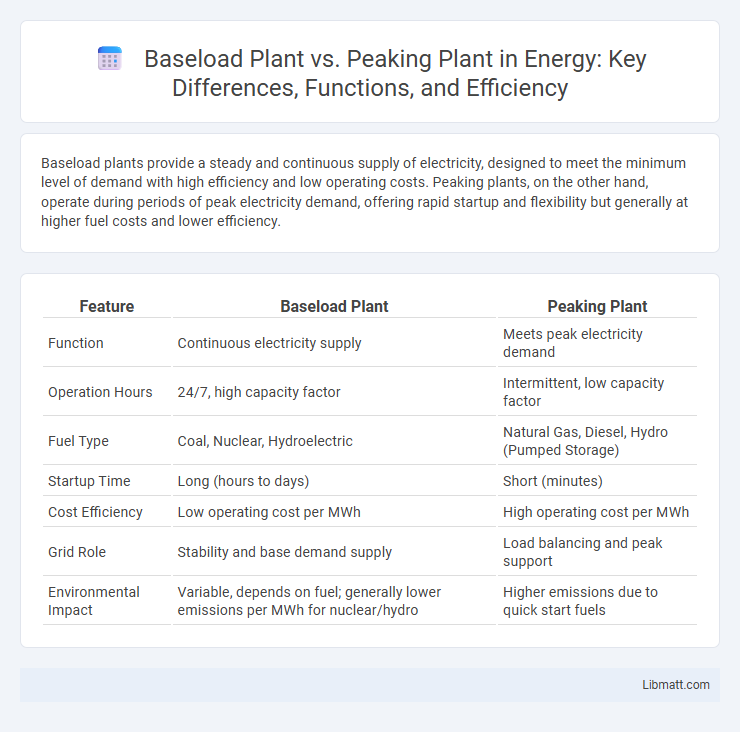Baseload plants provide a steady and continuous supply of electricity, designed to meet the minimum level of demand with high efficiency and low operating costs. Peaking plants, on the other hand, operate during periods of peak electricity demand, offering rapid startup and flexibility but generally at higher fuel costs and lower efficiency.
Table of Comparison
| Feature | Baseload Plant | Peaking Plant |
|---|---|---|
| Function | Continuous electricity supply | Meets peak electricity demand |
| Operation Hours | 24/7, high capacity factor | Intermittent, low capacity factor |
| Fuel Type | Coal, Nuclear, Hydroelectric | Natural Gas, Diesel, Hydro (Pumped Storage) |
| Startup Time | Long (hours to days) | Short (minutes) |
| Cost Efficiency | Low operating cost per MWh | High operating cost per MWh |
| Grid Role | Stability and base demand supply | Load balancing and peak support |
| Environmental Impact | Variable, depends on fuel; generally lower emissions per MWh for nuclear/hydro | Higher emissions due to quick start fuels |
Introduction to Baseload and Peaking Plants
Baseload plants, including coal, nuclear, and hydroelectric facilities, consistently supply a stable amount of electricity to meet the minimum demand on the grid 24/7. Peaking plants, often powered by natural gas turbines, operate only during periods of peak electricity demand to quickly balance the grid. Understanding the operational roles of these plants is essential for optimizing grid reliability and managing energy costs.
Defining Baseload Power Plants
Baseload power plants provide a continuous and reliable supply of electricity to meet the minimum demand on the grid, operating at high capacity factors often above 70%. These plants typically include coal-fired, nuclear, and large hydroelectric facilities known for their stable output and low production costs over time. Unlike peaking plants, baseload plants run 24/7 to maintain grid stability and support constant energy consumption patterns.
Characteristics of Peaking Power Plants
Peaking power plants are designed to operate during periods of highest electricity demand, providing quick and flexible energy output with rapid startup times. They typically rely on natural gas turbines or diesel engines, enabling them to ramp up within minutes, though they have higher operational costs and lower efficiency compared to baseload plants. Your energy strategy benefits from peaking plants by ensuring grid stability and meeting sudden surges in consumption.
Energy Generation Technologies Used
Baseload plants primarily use energy generation technologies such as coal, nuclear, and hydroelectric power, which can produce a steady and continuous output to meet constant electricity demand. Peaking plants rely on fast-start technologies like gas turbines and diesel generators, designed to quickly supply additional power during periods of peak demand. Your choice between these plants affects grid stability and energy costs depending on their technology and operational role.
Operational Differences
Baseload plants operate continuously at a consistent output to meet the minimum demand on an electrical grid, utilizing fuels like coal, nuclear, or hydro for steady energy production. Peaking plants, often powered by natural gas turbines, run only during periods of highest electricity demand, providing rapid response but at higher operational costs. Your energy management strategy should consider the balance between the stable output of baseload plants and the flexible, on-demand capability of peaking plants.
Cost Considerations
Baseload plants typically incur higher initial capital costs due to large-scale infrastructure but benefit from lower operational expenses and consistent fuel usage, providing more cost-effective electricity generation over time. Peaking plants usually have lower upfront costs but face higher operational and fuel costs per unit of electricity, as they run intermittently during periods of peak demand. Your choice depends on balancing steady, low-cost power supply against flexible, higher-cost generation for peak periods.
Environmental Impact
Baseload plants, typically using coal or nuclear energy, generate consistent power but often produce higher greenhouse gas emissions or radioactive waste, contributing significantly to environmental pollution and climate change. Peaking plants, usually natural gas turbines, emit fewer pollutants per unit of energy but operate intermittently, leading to less overall environmental impact compared to baseload plants. Utilizing renewable energy for peaking purposes can further reduce the carbon footprint and minimize harmful effects on ecosystems.
Role in Grid Stability
Baseload plants provide continuous and reliable power essential for maintaining grid stability by meeting the constant minimum demand. Peaking plants quickly respond to fluctuations and sudden spikes in electricity consumption, ensuring the grid remains balanced during high-demand periods. Your effective grid management depends on the seamless integration of both baseload and peaking plants to prevent outages and maintain voltage stability.
Challenges and Future Trends
Baseload plants face challenges such as high operational inflexibility and environmental concerns due to continuous fuel consumption, while peaking plants struggle with high startup costs and lower efficiency during short, intermittent usage. Future trends emphasize integrating advanced energy storage systems and smart grid technologies to enhance the flexibility of baseload plants and improve the responsiveness of peaking plants. Innovations in renewable energy sources and demand response mechanisms are driving a more adaptive and sustainable power generation landscape.
Conclusion: Choosing the Right Plant
Baseload plants provide consistent, reliable power with high efficiency, ideal for meeting continuous demand, while peaking plants deliver rapid, flexible electricity during periods of high consumption but at higher operational costs. Your choice depends on balancing cost-efficiency, demand variability, and grid stability requirements to optimize overall energy system performance. Integrating both types often ensures a resilient, cost-effective power supply that adapts to fluctuating energy needs.
Baseload plant vs Peaking plant Infographic

 libmatt.com
libmatt.com